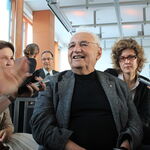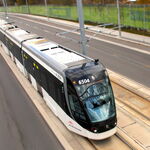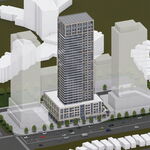waterloowarrior
Senior Member
Metrolinx Unveils Next Wave of Big Move Projects
http://www.newswire.ca/en/story/1080785/metrolinx-unveils-next-wave-of-big-move-projects
TORONTO, Nov. 29, 2012 /CNW/ - At an address today to the Toronto Board of Trade Metrolinx President and CEO Bruce McCuaig unveiled the next wave of projects drawn from The Big Move, the Regional Transportation Plan for the Greater Toronto and Hamilton Area (GTHA), that will continue Metrolinx's ongoing transformation of the region's transportation system.
"The Big Move is our plan to tackle gridlock across the Greater Toronto and Hamilton Area by building new transit and integrating our transportation system so that it's easier for everyone to get around," said Bruce McCuaig. "We already have over $16 billion invested in projects from The Big Move that are now in progress, but we need to keep moving forward and that's why I'm pleased to unveil the next wave of projects."
The Big Move projects in the next wave include two new subway lines: a Downtown Relief line improving access to the regional core for residents from across the GTHA, as well as a new extension of the Yonge subway line north to Richmond Hill. Light rail transit (LRT) in Mississauga, Brampton and Hamilton, and bus rapid transit (BRT) in Durham, Toronto, Peel and Halton, will reduce congestion and serve as a catalyst for development across the GTHA. The next wave also includes transformative investment in the GO Transit rail network, including line extensions, more two-way, all-day service, and electrification of both GO lines and the Union Pearson Express (formerly known as the Air Rail Link).
The next wave of proposed investment extends beyond major rapid transit projects to include resources for local transit, roads, active transportation and other strategic transportation initiatives.
"With our plan in place, it's now time for the big conversation about the best ways to pay for this $34 billion investment," said McCuaig. "Together, let's look to what other world class cities have done to fund their transit plans and then get the job done here in the GTHA."
The Big Move, adopted unanimously in 2008 by the Metrolinx Board of Directors, was developed through intensive public consultation and collaboration with key stakeholders, municipal leaders and professionals throughout the region. An update to The Big Move is proposed that will incorporate the findings of recent, more detailed studies to refine elements of the plan to meet emerging transit needs. The proposed updates will be posted on the Metrolinx website on December 5 for public comment.
Over $16 billion from all three levels of government has already been allocated to a first wave of projects drawn from The Big Move, the largest financial commitment to transit expansion in Canadian history. Major projects in this first wave are now under construction, including the Eglinton-Scarborough Crosstown LRT, the Toronto-York Spadina subway extension, the Mississauga BRT, the Union Pearson Express and new dedicated bus lanes in York Region.
See the full list of the proposed projects in the backgrounder.
Metrolinx is working to provide residents and businesses in the Greater Toronto & Hamilton Area with a transportation system that is modern, efficient and integrated. Find out more about The Big Move, Metrolinx's Regional Transportation Plan for the GTHA. Find out more about GO Transit, PRESTO, and Union Pearson Express, divisions of Metrolinx.
Disponible en français.
Backgrounder
The Big Move's next wave of projects will continue Metrolinx's transformation of the region's transportation system by expanding the regional transit network as well as providing resources for local transit, roads, active transportation and more.
The Next Wave: Key Facts
75 per cent of proposed investment is allocated to a transformative slate of regional transit projects:
Local transit, roads and highways and other projects
SOURCE: Metrolinx
http://www.newswire.ca/en/story/1080785/metrolinx-unveils-next-wave-of-big-move-projects
TORONTO, Nov. 29, 2012 /CNW/ - At an address today to the Toronto Board of Trade Metrolinx President and CEO Bruce McCuaig unveiled the next wave of projects drawn from The Big Move, the Regional Transportation Plan for the Greater Toronto and Hamilton Area (GTHA), that will continue Metrolinx's ongoing transformation of the region's transportation system.
"The Big Move is our plan to tackle gridlock across the Greater Toronto and Hamilton Area by building new transit and integrating our transportation system so that it's easier for everyone to get around," said Bruce McCuaig. "We already have over $16 billion invested in projects from The Big Move that are now in progress, but we need to keep moving forward and that's why I'm pleased to unveil the next wave of projects."
The Big Move projects in the next wave include two new subway lines: a Downtown Relief line improving access to the regional core for residents from across the GTHA, as well as a new extension of the Yonge subway line north to Richmond Hill. Light rail transit (LRT) in Mississauga, Brampton and Hamilton, and bus rapid transit (BRT) in Durham, Toronto, Peel and Halton, will reduce congestion and serve as a catalyst for development across the GTHA. The next wave also includes transformative investment in the GO Transit rail network, including line extensions, more two-way, all-day service, and electrification of both GO lines and the Union Pearson Express (formerly known as the Air Rail Link).
The next wave of proposed investment extends beyond major rapid transit projects to include resources for local transit, roads, active transportation and other strategic transportation initiatives.
"With our plan in place, it's now time for the big conversation about the best ways to pay for this $34 billion investment," said McCuaig. "Together, let's look to what other world class cities have done to fund their transit plans and then get the job done here in the GTHA."
The Big Move, adopted unanimously in 2008 by the Metrolinx Board of Directors, was developed through intensive public consultation and collaboration with key stakeholders, municipal leaders and professionals throughout the region. An update to The Big Move is proposed that will incorporate the findings of recent, more detailed studies to refine elements of the plan to meet emerging transit needs. The proposed updates will be posted on the Metrolinx website on December 5 for public comment.
Over $16 billion from all three levels of government has already been allocated to a first wave of projects drawn from The Big Move, the largest financial commitment to transit expansion in Canadian history. Major projects in this first wave are now under construction, including the Eglinton-Scarborough Crosstown LRT, the Toronto-York Spadina subway extension, the Mississauga BRT, the Union Pearson Express and new dedicated bus lanes in York Region.
See the full list of the proposed projects in the backgrounder.
Metrolinx is working to provide residents and businesses in the Greater Toronto & Hamilton Area with a transportation system that is modern, efficient and integrated. Find out more about The Big Move, Metrolinx's Regional Transportation Plan for the GTHA. Find out more about GO Transit, PRESTO, and Union Pearson Express, divisions of Metrolinx.
Disponible en français.
Backgrounder
The Big Move's next wave of projects will continue Metrolinx's transformation of the region's transportation system by expanding the regional transit network as well as providing resources for local transit, roads, active transportation and more.
The Next Wave: Key Facts
- 713 km of enhanced transit
- 33 million new transit trips by 2031
- 6,139,344 people will live within 2 km of rapid transit by 2031
- 800,000 to 900,000 new jobs created between 2012 to 2031
- $110 to $130 billion growth to Ontario's GDP between 2012 to 2031
- $25 to $35 billion in total Government Revenues between 2012 to 2031
- Rapid Transit Projects:
75 per cent of proposed investment is allocated to a transformative slate of regional transit projects:
- Brampton Queen Street Rapid Transit: 10 km of upgraded transit along Queen Street.
- Downtown Relief Line: New subway that will improve access to the regional core for residents from across the Greater Toronto and Hamilton Area (GTHA) and provide relief to the overflowing arteries of the Toronto transit system.
- Dundas Street Bus Rapid Transit: 40 km of bus service running in dedicated lanes, connecting Toronto, Mississauga and Halton.
- Durham-Scarborough Bus Rapid Transit: 36 km of bus service running in dedicated lanes, connecting Scarborough Centre to downtown Oshawa via Pickering, Ajax and Whitby.
- GO Rail Expansion: More Two-Way, All-Day and Rush Hour Service: Introducing more two-way, all-day service, adding additional rush hour service across the entire network, and extending trains to Hamilton and Bowmanville.
- Electrification of GO Kitchener line and Union Pearson Express: Upgrading diesel train service to electric propulsion for these two complementary transit services that share a substantial portion of their routing.
- GO Lakeshore Express Rail Service - Phase 1 (including Electrification): Transforming GO Transit's backbone from Hamilton to Oshawa into a faster, more frequent and more convenient transit option by beginning the transition to an international-style Express Rail service.
- Hamilton Light Rail Transit: 14 km LRT line stretching from McMaster University to Eastgate Square.
- Hurontario-Main Light Rail Transit: 23 km LRT line connecting Port Credit to downtown Brampton via Cooksville and Mississauga City Centre.
- Yonge North Subway Extension: 6 km extension that will connect the City of Toronto to the Richmond Hill / Langstaff Urban Growth Centre.
Local transit, roads and highways and other projects
- The remaining 25 per cent is allocated to local transit projects, as well as roads and highways, active transportation and transportation demand management throughout the region.
SOURCE: Metrolinx




